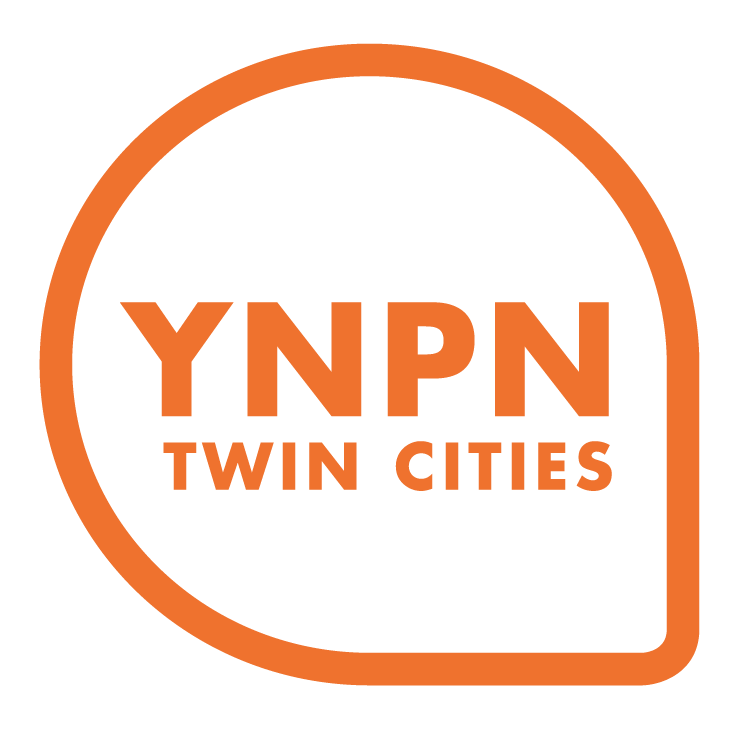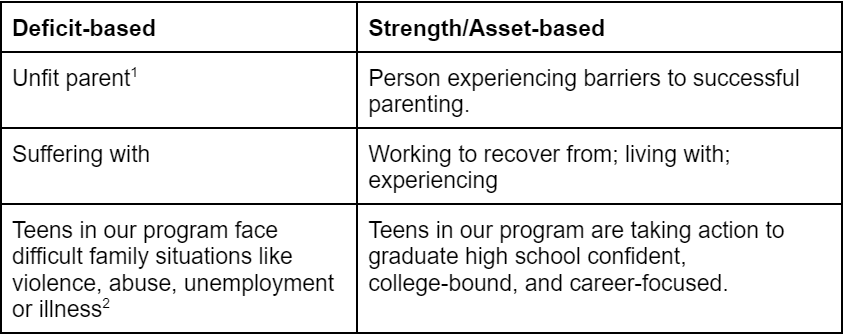Person-First, Strength-Based Language is for Everyone!
by Alyssa Scott
When I began working in nonprofits, I was in fundraising and had the glamorous job of writing the letters you receive in the mail asking for money. As I took inventory of past direct mail appeals, I began to notice the way organizations talked about the individuals they supported and served; the language often felt a little cringey.
If you do, or ever have, felt that way about things written at your organization, let me introduce you to person-centered language!
While I now work in research, I still write a lot of public-facing content. A goal of mine is to use language that is truthful, strengths-based, and free of bias. Just as we’ve all learned to edit for spelling and grammar, why can’t we add a lens of editing for how we talk about people?
Based on the research I’ve done to educate others about person-centered and strengths-based language, I’ve come up with three guidelines.
Guideline 1: Describe who you are talking about with as much specificity as possible.
This helps avoid stereotypes and generalizations that may perpetuate harmful narratives about groups of people. If you aren’t sure how to refer to a person, ask them directly or other staff members who communicate with them regularly. This is a great opportunity to engage more deeply with them!
Example: This might mean identifying a family as Mexican rather than Latinx, or Somali rather than Black/African American.
Guideline 2: Use strengths- or asset-based language to describe people and their experiences.
Deficit-based language can sometimes depersonalize or dehumanize the experience of people we work with, even leading to negative biases staff or other stakeholders have about them. It is much more powerful to focus on the unique strengths and assets of individuals and how we work together to build upon those strengths.
Example: Below are some examples that compare deficit-based language and strengths-based language to talk about situations and experiences that may or may not be relevant for your organization.
Guideline 3: Person-first language is a helpful way to center the individual(s) you are talking about.
This is another way to be strengths and asset-based. Person-first language means you use words that refer to the people you’re talking about as people, first and foremost. By talking about the person first and describing who they are, rather than using a term that might have a negative connotation or pass judgment on a specific situation, you demonstrate respect and that you value their lived experience. This can then create opportunities for stronger partnerships.
It’s okay to share some real examples of an individual’s lived experience with their permission. If you feel uncertain, consult with them directly about language they would prefer when discussing their experience, or ask a staff member who communicates with them more regularly to help facilitate that conversation.
Example: A good rule of thumb is to transform words that describe an individual into phrases that literally start with “person” and then change that into a more relevant descriptor of the type of person they are or role they play.
Instead of referring to families as poor or impoverished, say “families living in poverty.”
Instead of referring to an individual as mentally ill, say “person with a mental illness.”
Instead of describing an individual as an addict, say “person with a substance use disorder.”
Here are some additional things to consider when sharing stories or information about individuals impacted by your work:
Have you let them know you’re sharing their story or let them review it?
Am I making assumptions about the individual’s class or race?
Is the language used offensive or relatable to someone with a similar lived experience?
Do I write about this topic assuming an audience that might include non-White folks, lower-income folks, or the individual themself are going to read it?
Does the story depict a cliche or stereotype?
Does the story depict your organization or staff at your organization as saviors?
Does the story have an antagonist? Who is it?
If you feel like you need additional support reframing your story or message to focus more on the three guidelines above, here are some questions to guide you:
How can you highlight this individual’s unique journey?
What positive language would you use to describe the individual or your interactions with them? Incorporate them into the narrative so everyone who reads it can feel that about them, too.
If there needs to be an antagonist, is there a way to highlight the systems that aren’t working to support the individual rather than actions of the individual?
How can you talk about the way your organization interacts with and supports this individual in a way that demonstrates the relationships and partnerships that are being built?
Remember that you can always rely on staff who have more direct communication with individuals your organization works with to help you think about these questions or facilitate conversations with that individual.
Language is incredibly powerful. By adding a step to edit your writing for how you talk about people, you can demonstrate respect for lived experiences that are different than your own, honor the people you and your organization work with, and even deepen your relationships and partnerships with them. And this is just a start; it’s not a perfect or exhaustive list for how to respectfully write about individuals! There are countless resources, including the ones I share below.
- Alyssa Scott -
Resources:
https://prosper-strategies.com/strength-based-communication/
https://practicetransformation.umn.edu/clinical-tools/person-centered-language/
https://www.suwn.org/storage/documents/2016_wordsmatter_101917.pdf



